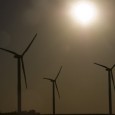The Gift of South Dakota
Subscriptions to South Dakota Magazine make great gifts!
Subscribe today — 1 year (6 issues) is just $29!
Not Enough Juice
Feb 14, 2013
As Orco roared through the Dakotas, dumping white powder on my sidewalk faster than I could shovel it off, it occurred to me that this might have been the first time that I was ever on a first name basis with a snow storm. It took the weather channel rather a long time to figure out that it could goose a little more drama out of wind and ice by giving storms names that sound like Japanese monsters.
I didn’t really mind the blizzard, much. In fact, it looked to me like the Good Lord’s way of declaring an impromptu holiday. Of course, I didn’t have to go out to plow roads or look for stranded cars driven by folks who ignored the no travel warnings. Perhaps the unlucky drivers didn’t have cell phones or just had stupid cell phones. My smart phone was texting me daily with warnings about blizzard conditions. It was sort of like having a portable mom.
I also don’t have an electric car. In particular, I don’t have a Tesla Model S Sedan of the sort recently tested by New York Times reporter John Broder. There are several reasons I don’t have one. The first is that the luxury vehicle would be affordable for me only if I didn’t eat or make house payments for about two years. Another reason is that I find it hard to see the sense of a car that takes an hour to refuel, or recharge as it were, even if charging stations were available in this area. They aren’t, and I very much doubt that they will be anytime soon.
Broder took the car on a drive from Washington, D.C. to Delaware and discovered that electricity evaporates much faster than gasoline. The onboard computer, apparently not as helpful as my smart phone, promised him a lot more miles than it could deliver. As the juice ran out, he was instructed to drive rather more slowly than the flow of traffic and, sorry, turn off the heater. Over a cold night, the car lost two-thirds of its charge. The next day, after a full charge, it shut down leaving Broder stranded and cold on the side of the road. When the tow truck arrived, it turned out that the brakes wouldn’t release without power. He had to wait for forty-five minutes while the car was dragged onto the flatbed.
There is a lot of mystery in a hundred-thousand-dollar car that performs like it was cursed by some ancient god. One mystery is why anyone is building electric cars. Yes, they are quiet and produce no carbon emissions while you are driving them. But the electricity that turns the engine (while you have some of it left) wasn’t produced by unicorns pushing a pinwheel. Nor are the batteries and expensive components made out of tofu. Every stage of production and operation requires inputs of energy and will produce carbon emissions and waste. Those will determine what the environmental footprint of the car really is.
Another mystery is how the car comes to exist in the first place. When a company invests millions in producing a sophisticated vehicle, it is usually because it expects to make millions selling them. Maybe Tesla really expects to sell its cars, starting out at $60,000, in numbers sufficient recover its costs. What the business model looks like, however, is a device for milking enormous amounts of federal cash. In 2010, Tesla obtained a $465 million loan from the Department of Energy. Such largess is one reason that the Sedan was built. Another, probably, is the rule passed in Sacramento requiring auto companies to produce “zero emission” cars.
There is nothing wrong with government investments in new technologies. Funding research is one thing, however; funding the creation of an industry that is not now and may never be ready to survive in the marketplace is something else. We ought to care about the environment. Caring, however, will not solve any environmental problems nor will such problems be solved by sparkling ideas unmoored in reality.
My RAV 4 has a tailpipe, God forgive me, even if it is reasonably fuel efficient as such things go. I could be reasonably certain that it would start up and that there would be as much gas in the tank as there was when Orco arrived. Now, if I could only get it out of my driveway after a big storm.
Editor's Note: Ken Blanchard is our political columnist from the right. For a left-wing perspective on politics, please look for columns by Cory Heidelberger every other Wednesday on this site.
Dr. Ken Blanchard is a professor of Political Science at Northern State University and writes for the Aberdeen American News and the blog South Dakota Politics.











Comments
Spot on ! Solyndra, etc. etc. etc. etc. deleloped the same business plan. Securing millions from the government while no respecting financial institution would touch you, pretending to run a real business, and declaring bankruptcy after the grant money has disappeared is the "green" these opportunists are interested in.
I would be interested in learning of any alternative energy business that has actually shown a profit ( or broke even) without federal subsidies.